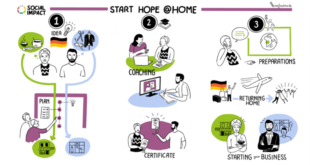Official figures reveal that the EU received more than 1.14 million asylum applications in 2023, the highest number since 2016. Far-right parties could capitalize on the influx in June’s EU elections. Jack Parrock reports
More than 1.14 million people applied for asylum in the EU in 2023, according to annual figures released by the European Union Agency for Asylum (EUAA).
It is the largest number of applications in the European Union and the closely aligned EU+ countries Norway and Switzerland since displaced people arrived in the bloc en masse from 2015 through 2016.
Germany received 29% of the asylum applications, with more than 334,000 people seeking protection in 2023. The nationalist Alternative for Germany (AfD) party has used the topic of migration to surge to 19% support in the country.
France (167,000), Spain (162,000) and Italy (136,000) followed as the biggest recipients of applications. With 12,000 applications, Cyprus received the most relative to its population of 1.2 million.
Countries of origin
Continuing a years-long trend, Syrian nationals submitted the most applications in 2023, with 181,000. Afghanistan remained the second largest country of origin, with 114,000 applications from nationals in 2023.
Last year also saw an 82% increase of in the number of Turkish citizens applying for international protection in the EU, at more than 100,000.
The EUAA acknowledges that the numbers in its annual report do not “paint a complete picture” across the European Union.
The 4.4 million Ukrainians who have relocated into the European Union since the start of Russia’s full-scale invasion are not included as they have been provided “temporary protection” and do not need to formally apply for asylum.
Palestinians applying for asylum in the European Union jumped to a record high of more than 11,000, up from about 6,700 in 2022.
“The increased numbers are not unexpected, because of the increase in geopolitical instability around the world, with growing conflicts in regions not far from Europe,” Alberto‑Horst Neidhardt, a senior policy analyst at the European Policy Centre think tank, told DW.
‘A legal right to protection’
The most recent “Global Trends” report from the UN Refugee Agency found that 110 million people worldwide were forcibly displaced from their homes, an increase of more than 1.6 million people from the end of 2022.
“There are record numbers of people displaced globally, and we see that a consistent 10%, or around that figure, may seek protection in Europe,” Catherine Woollard, the director of the European Council of Refugees and Exiles (ECRE) NGO, told DW. “If we look at global displacement and the proportion of people who actually come to Europe, the numbers are not that high relative to what other countries and other regions of the world are managing.”
According to the EUAA’s figures, 43% of asylum applications in the European Union were approved in 2023.
“If we also add in the number who get protection status under national law [not only international], that takes the figures well over 50%,” Woollard said. “So the majority of those coming are in need and have a legal right to protection in the EU.”
EU asylum overhaul
In December, EU member states and the European Parliament agreed to a major overhaul of the bloc’s asylum and migration laws.
The overhaul included provisions for faster vetting of irregular arrivals, the creation of border detention centers and quicker deportation for asylum-seekers whose requests have been rejected.
It also included a “solidarity mechanism,” whereby some asylum applicants would be transferred between EU member states and countries that refuse to take them in would make financial or material contributions to countries that do.
European Commission Vice President Margaritis Schinas called the agreement a “breakthrough,” but Hungary and Poland’s government at the time stringently opposed the deal.
“We need to keep in mind that these reforms will only become enforceable as of 2026,” Neidhardt said. “There is also a risk of overinflated expectations by the voters, that now we have these reforms, all the problems in relation to how migration has been dealt with in the past will be solved overnight.”
European Parliament elections
The annual asylum figures were released as campaigning for June’s European Parliament elections has ramped up in earnest, with migration being a high priority for voters in many EU countries.
The most recent “Europe Elects” poll projects that the AfD will win 22 of Germany’s seats in the European Parliament in June, the second-highest total after the bloc of the Christian Democrats and Christian Social Union.
“I fully expect far-right parties in Germany and elsewhere to use these [asylum] numbers to their advantage to push their agendas,” Neidhardt said.
“The reality is also that mainstream parties — the center right, center left and liberals — have placed a huge bet on the migration reforms in the hope that they will convince their voters that they are dealing with how migration is managed,” he said.
The AfD is campaigning on a promise to clamp down on the entry of migrants into the European Union and Germany.
The party’s counterparts in France, Austria, Italy and across the European Union are also hoping to make significant electoral gains. If far-right parties from different countries can put aside their differences and unite in the European Parliament, they could become a major force in EU lawmaking.
Edited by: M. Gagnon
© DW
 THE AFRICAN COURIER. Reporting Africa and its Diaspora! The African Courier is an international magazine published in Germany to report on Africa and the Diaspora African experience. The first issue of the bimonthly magazine appeared on the newsstands on 15 February 1998. The African Courier is a communication forum for European-African political, economic and cultural exchanges, and a voice for Africa in Europe.
THE AFRICAN COURIER. Reporting Africa and its Diaspora! The African Courier is an international magazine published in Germany to report on Africa and the Diaspora African experience. The first issue of the bimonthly magazine appeared on the newsstands on 15 February 1998. The African Courier is a communication forum for European-African political, economic and cultural exchanges, and a voice for Africa in Europe.

































